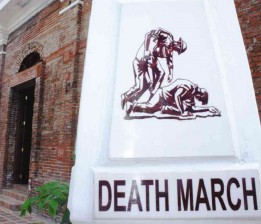Death March landmark in Pampanga saved

LAST STOP A marker of the 1942 Death March installed at the San Fernando train station in Pampanga recalls how this restored landmark became the last stop for Filipino and American soldiers forced by their Japanese captors to walk 104 kilometers during World War II. E.I. REYMOND T. OREJAS/INQUIRER CENTRAL LUZON
CITY OF SAN FERNANDO, Philippines—An old train station in this Pampanga capital that became a landmark for freedom both during the time of national hero Jose Rizal and during World War II has been saved from neglect and oblivion, thanks to eight years of hard work by local heritage advocates and tourism officials.
On Tuesday morning, city officials and leaders of the private sector will walk the last 2 kilometers of the Death March from Heroes Hall at the City Hall annex to the train station, city tourism officer Ma. Lourdes Pangilinan-Gonzales said.
She added that the first of a series of life-size monuments by commissioned sculptor Juan Sajid Imao that was meant to highlight the historical significance of the train station will also be unveiled Tuesday.
Last stop
The train station was part of the Philippine National Railways’ Manila-Dagupan route until after World War II, and became the last stop of some 80,000 Filipino and American soldiers during the infamous Death March 71 years ago.
The station, also known as Kilometer 102, is remembered as well for serving as a recruitment stop for Rizal who visited San Fernando and Bacolor town on June 27, 1892.
To protect the historic but neglected site in Sitio (settlement) PNR in Barangay (village) Sto. Niño here, the National Historical Institute listed it as a historical landmark in 2006 to honor Filipino veterans of World War II.
As early as 2005, the San Fernando Heritage Foundation began raising funds for the restoration of the station. In 2010 and 2011, the Philippine Tourism Authority (now known as the Tourism Infrastructure and Enterprise Zone Authority, or Tieza), funded the restoration project, and turned over its maintenance to the city government the following year.
Records of the city government showed that in February 1892, Governor General Eulogio Despujol inaugurated the train station as part of the Manila-Dagupan line of the old PNR.
La Liga Filipina recruitment
A day after arriving from Hong Kong in June 1892, Rizal visited Pampanga and met his Kapampangan friends and masonic brothers in the station, apparently to recruit members for the La Liga Filipina.
To members of the American Defenders of Bataan and Corregidor, however, the station recalled the 65-mile (104-km) walk forced on them by the Japanese military after the fall of Bataan on April 9, 1942, which they described as “one of the earliest and most severe mistreatment of prisoners of war.”














